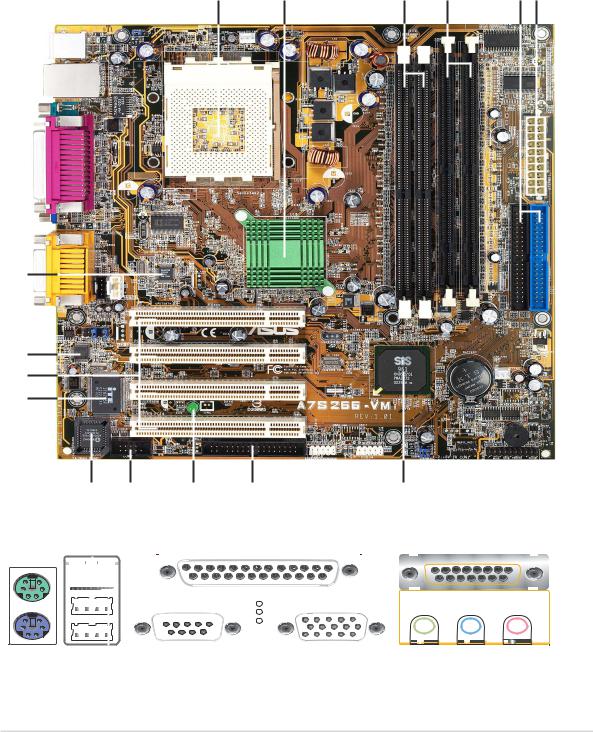ASUS A7S266-VM User Manual

A7S266-VM
User Guide
Motherboard

E1116
First Edition
August 2002
Copyright © 2002 ASUSTeK COMPUTER INC. All Rights Reserved.
No part of this manual, including the products and software described in it, may be reproduced, transmitted, transcribed, stored in a retrieval system, or translated into any language in any form or by any means, except documentation kept by the purchaser for backup purposes, without the express written permission of ASUSTeK COMPUTER INC. (“ASUS”).
Product warranty or service will not be extended if: (1) the product is repaired, modified or altered, unless such repair, modification of alteration is authorized in writing by ASUS; or (2) the serial number of the product is defaced or missing.
ASUS PROVIDES THIS MANUAL “AS IS” WITHOUT WARRANTY OF ANY KIND, EITHER EXPRESS OR IMPLIED, INCLUDING BUT NOT LIMITED TO THE IMPLIED WARRANTIES OR CONDITIONS OF MERCHANTABILITY OR FITNESS FOR A PARTICULAR PURPOSE. IN NO EVENT SHALL ASUS, ITS DIRECTORS, OFFICERS, EMPLOYEES OR AGENTS BE LIABLE FOR ANY INDIRECT, SPECIAL, INCIDENTAL, OR CONSEQUENTIAL DAMAGES (INCLUDING DAMAGES FOR LOSS OF PROFITS, LOSS OF BUSINESS, LOSS OF USE OR DATA, INTERRUPTION OF BUSINESS AND THE LIKE), EVEN IF ASUS HAS BEEN ADVISED OF THE POSSIBILITY OF SUCH DAMAGES ARISING FROM ANY DEFECT OR ERROR IN THIS MANUAL OR PRODUCT.
SPECIFICATIONS AND INFORMATION CONTAINED IN THIS MANUAL ARE FURNISHED FOR INFORMATIONAL USE ONLY, AND ARE SUBJECT TO CHANGE AT ANY TIME WITHOUT NOTICE, AND SHOULD NOT BE CONSTRUED AS A COMMITMENT BY ASUS. ASUS ASSUMES NO RESPONSIBILITY OR LIABILITY FOR ANY ERRORS OR INACCURACIES THAT MAY APPEAR IN THIS MANUAL, INCLUDING THE PRODUCTS AND SOFTWARE DESCRIBED IN IT.
Products and corporate names appearing in this manual may or may not be registered trademarks or copyrights of their respective companies, and are used only for identification or explanation and to the owners’ benefit, without intent to infringe.
ii

Contents
Contents |
......................................................................................... |
iii |
FCC/CDC statements ...................................................................... |
v |
|
Federal Communications Commission Statement ................. |
v |
|
Canadian Department of Communications Statement ........... |
v |
|
Safety information .......................................................................... |
vi |
|
About this guide ............................................................................. |
vii |
|
Conventions used in this guide ............................................ |
vii |
|
Where to find more information ............................................ |
vii |
|
ASUS contact information ............................................................. |
vii |
|
Specifications summary ................................................................. |
ix |
|
Chapter 1 - Motherboard Info ................................................... |
1-1 |
|
1.1 |
Welcome ...................................................................... |
1-2 |
1.2 |
Package contents ....................................................... |
1-2 |
1.3 |
Introduction.................................................................. |
1-3 |
1.4 |
Motherboard components .......................................... |
1-3 |
1.5 |
Motherboard layout..................................................... |
1-6 |
1.6 |
Before you proceed..................................................... |
1-7 |
1.7 |
Central Processing Unit (CPU)................................... |
1-7 |
1.8 System memory........................................................... |
1-8 |
|
1.9 |
Expansion Slots........................................................... |
1-9 |
1.9.1 Configuring an expansion card .................................. |
1-9 |
|
1.9.2 Standard Interrupt Assignments ................................ |
1-9 |
|
1.10 Jumpers ....................................................................... |
1-10 |
|
1.11 Connectors ................................................................. |
1-11 |
|
Chapter 2 - BIOS Information ..................................................... |
.2-1 |
|
2.1 |
Managing and updating your BIOS ............................ |
2-2 |
2.1.1 Using ASUS EZFLASH to update the BIOS................ |
2-2 |
|
2.1.2 Using ASUS AFLASH to update the BIOS................... |
2-4 |
|
|
Updating BIOS procedures.................................... |
2-5 |
2.2 |
BIOS Setup Program ................................................... |
2-7 |
2.2.1 BIOS menu bar ........................................................... |
2-7 |
|
2.2.2 Legend bar .................................................................. |
2-8 |
|
iii

Contents
2.3 |
Main Menu .................................................................... |
2-9 |
2.3.1 Primary and Secondary Master/Slave......................... |
2-11 |
|
2.3.2 Keyboard Features ..................................................... |
2-13 |
|
2.4 Advanced Menu ........................................................... |
2-14 |
|
2.4.1 Chip Configuration ...................................................... |
2-15 |
|
2.4.2 I/O Device Configuration ............................................. |
2-17 |
|
2.4.3 PCI Configuration ........................................................ |
2-18 |
|
2.4.3.1 PCI IRQ Resource Exclusion ................................... |
2-19 |
|
2.5 Power Menu .................................................................. |
2-20 |
|
2.5.1 Power-up Control ........................................................ |
2-22 |
|
2.5.2 Hardware Monitor ........................................................ |
2-23 |
|
2.6 |
Boot Menu ..................................................................... |
2-24 |
2.7 |
Exit Menu ................................................................. |
2-25 |
Chapter 3 - Starting Up .............................................................. |
3-1 |
|
3.1 |
Install an operating system......................................... |
3-2 |
3.2 |
Support CD information.............................................. |
3-2 |
3.2.1 Running the support CD ............................................ |
3-2 |
|
3.2.2 Software drivers and installation menus .................... |
3-3 |
|
3.3 |
Software Information................................................... |
3-5 |
3.3.1 ASUS Update ............................................................. |
3-5 |
|
3.3.2 ASUS PC Probe ......................................................... |
3-6 |
|
|
Starting ASUS PC Probe ...................................... |
3-6 |
|
Using ASUS PC Probe ......................................... |
3-7 |
|
ASUS PC Probe Task Bar Icon ............................ |
3-9 |
iv

FCC/CDC statements
Federal Communications Commission Statement
This device complies with FCC Rules Part 15. Operation is subject to the following two conditions:
•This device may not cause harmful interference, and
•This device must accept any interference received including interference that may cause undesired operation.
This equipment has been tested and found to comply with the limits for a Class B digital device, pursuant to Part 15 of the FCC Rules. These limits are designed to provide reasonable protection against harmful interference in a residential installation. This equipment generates, uses and can radiate radio frequency energy and, if not installed and used in accordance with manufacturer’s instructions, may cause harmful interference to radio communications. However, there is no guarantee that interference will not occur in a particular installation. If this equipment does cause harmful interference to radio or television reception, which can be determined by turning the equipment off and on, the user is encouraged to try to correct the interference by one or more of the following measures:
•Reorient or relocate the receiving antenna.
•Increase the separation between the equipment and receiver.
•Connect the equipment to an outlet on a circuit different from that to which the receiver is connected.
•Consult the dealer or an experienced radio/TV technician for help.
The use of shielded cables for connection of the monitor to the graphics card is required to assure compliance with FCC regulations. Changes or modifications to this unit not expressly approved by the party responsible for compliance could void the user’s authority to operate this equipment.
Canadian Department of Communications Statement
This digital apparatus does not exceed the Class B limits for radio noise emissions from digital apparatus set out in the Radio Interference Regulations of the Canadian Department of Communications.
This class B digital apparatus complies with Canadian ICES-003.
v

Safety information
Electrical safety
•To prevent electrical shock hazard, disconnect the power cable from the electrical outlet before relocating the system.
•When adding or removing devices to or from the system, ensure that the power cables for the devices are unplugged before the signal cables are connected. If possible, disconnect all power cables from the existing system before you add a device.
•Before connecting or removing signal cables from the motherboard, ensure that all power cables are unplugged.
•Seek professional assistance before using an adpater or extension cord. These devices could interrupt the grounding circuit.
•Make sure that your power supply is set to the correct voltage in your area. If you are not sure about the voltage of the electrical outlet you are using, contact your local power company.
•If the power supply is broken, do not try to fix it by yourself. Contact a qualified service technician or your retailer.
Operation safety
•Before installing the motherboard and adding devices on it, carefully read all the manuals that came with the package.
•Before using the product, make sure all cables are correctly connected and the power cables are not damaged. If you detect any damage, contact your dealer immediately.
•To avoid short circuits, keep paper clips, screws, and staples away from connectors, slots, sockets and circuitry.
•Avoid dust, humidity, and temperature extremes. Do not place the product in any area where it may become wet.
•Place the product on a stable surface.
•If you encounter technical problems with the product, contact a qualified service technician or your retailer.
vi

Conventions used in this guide
To make sure that you perform certain tasks properly, take note of the following symbols used throughout this manual.
WARNING/DANGER: Information to prevent injury to yourself when trying to complete a task.
CAUTION: Information to prevent damage to the components when trying to complete a task.
IMPORTANT: Information that you MUST follow to complete a task.
NOTE: Tips and additional information to aid in completing a task.
Where to find more information
Refer to the following sources for additional information and for product and software updates.
1.ASUS Websites
The ASUS websites worldwide provide updated information on ASUS hardware and software products. The ASUS websites are listed in the ASUS Contact Information on page viii.
2.Optional Documentation
Your product package may include optional documentation, such as warranty flyers, that may have been added by your dealer. These documents are not part of the standard package.
vii

ASUS contact information
ASUSTeK COMPUTER INC. (Asia-Pacific)
Address: |
150 Li-Te Road, Peitou, Taipei, Taiwan 112 |
General Tel: |
+886-2-2894-3447 |
General Fax: |
+886-2-2894-3449 |
General Email: |
info@asus.com.tw |
Technical Support
MB/Others (Tel): |
+886-2-2890-7121 (English) |
Notebook (Tel): |
+886-2-2890-7122 (English) |
Desktop/Server (Tel): |
+886-2-2890-7123 (English) |
Support Fax: |
+886-2-2890-7698 |
Support Email: |
tsd@asus.com.tw |
Web Site: |
www.asus.com.tw |
Newsgroup: |
cscnews.asus.com.tw |
ASUS COMPUTER INTERNATIONAL (America)
Address: |
6737 Mowry Avenue, Mowry Business Center, |
|
Building 2, Newark, CA 94560, USA |
General Fax: |
+1-510-608-4555 |
General Email: |
tmd1@asus.com |
Technical Support
Support Fax: |
+1-510-608-4555 |
General Support: |
+1-502-995-0883 |
Web Site: |
www.asus.com |
Support Email: |
tsd@asus.com |
ASUS COMPUTER GmbH (Europe)
Address: |
Harkortstr. 25, 40880 Ratingen, BRD, Germany |
General Fax: |
+49-2102-442066 |
General Email: |
sales@asuscom.de (for marketing requests only) |
Technical Support
Support Hotline: |
MB/Others: +49-2102-9599-0 |
Notebook (Tel): |
+49-2102-9599-10 |
Support Fax: |
+49-2102-9599-11 |
Support (Email): |
www.asuscom.de/de/support (for online support) |
Web Site: |
www.asuscom.de |
viii

A7S266-VM specifications summary
CPU
Chipset
Front Side Bus (FSB)
Memory
Expansion slots
IDE
Audio (optional)
LAN (optional)
Special Features
Back Panel I/O Ports
Internal I/O
Connectors
Socket A for AMD Athlon XP/Athlon/Duron 2 GHz+ Thoroughbred core CPU ready
Northbridge: SiS 740
Southbridge: SiS 961B
266/200Mhz
2 x DDR DIMM Sockets
Max. 2 GB unbuffered PC2100/1600 non-ECC DDR SDRAM 2 x SDR DIMM Sockets
Max. 2 GB unbuffered PC133/100 non-ECC SDRAM (Note: DDR and SDR memory cannot be used on A7S266VM simultaneously.)
4 x PCI
2 x UltraDMA 133/100/66
C-media 4-channel CODEC
S/PDIF-out interface
SiS 961B integrated 10/100Mbps Fast Ethernet with Realtek external PHY
Power Loss Restart
ASUS Jumperfree
SFS (Stepless Frequency Selection)
support S/PDIF out interface (on audio model only) ASUS C.O.P. (CPU Overheating Protection)
1 x Parallel
1 x Serial
1 x VGA
1 x PS/2 Keyboard
1 x PS/2 Mouse
1 x Audio I/O, Game/MIDI (on audio model only)
2 x USB 1.1
1 x RJ-45 Port (on LAN model only)
CPU/Chassis FAN connector 20 pin ATX power connector IDE LED connector
SIR COM2 port
S/PDIF out connector (on audio model only) CD/AUX audio in (on audio model only)
Front panel audio connector (on audio model only)
2 x USB 1.1 connector supports additional 4 USB 1.1 ports
(continued on the next page)
ix

A7S266-VM specifications summary
BIOS features |
2Mb Flash ROM, EEPROM, ASUS JumperFree, Award |
|
|
BIOS with ACPI, DMI2.0, PnP, WfM2.0, Green, TCAV (Trend |
|
|
Chip Away Virus) |
|
|
|
|
Industry standard |
PCI 2.2, USB 1.1. |
|
|
|
|
Manageability |
WfM2.0, DMI2.0, WOR, WOL |
|
|
|
|
Form Factor |
ATX form factor: 9.6 in x 9.6 in (24.5 cm x 24.5 cm) |
|
|
|
|
Support CD contents |
Device drivers |
|
|
ASUS PC Probe |
|
|
Trend Microtm PC-cillin 2002 anti-virus software |
|
|
ASUS LiveUpdate Utility |
|
|
|
|
Accessories |
User’s manual |
|
|
Support CD |
|
|
1 x UltraDMA 133/100/66 cable |
|
|
FDD cable |
|
|
COM2 cable |
|
|
I/O shield |
|
|
|
|
|
|
|
* Specifications are subject to change without notice.
x

Chapter 1
This chapter gives information about the ASUS A7S266-VM motherboard that came with the system.This chapter includes the motherboard layout, jumper settings, and connector locations.
Motherboard Info
ASUS A7S266-VM Motherboard |
1-1 |

1.1Welcome!
Thank you for buying the ASUS® A7S266-VM motherboard!
The ASUS A7S266-VM motherboard is loaded with the most advanced technologies to deliver the maximum performance for socket A processors. This motherboard is loaded with value-added features for guaranteed consumer satisfaction.
Before you start installing the motherboard, and hardware devices on it, check the items in your package with the list below.
1.2Package contents
Check your ASUS A7S266-VM package for the following items.
ASUS A7S266-VM motherboard
ATX form factor: 9.6 in x 9.6 in (24.5 cm x 24.5 cm)
ASUS A7S266-VM series support CD
1 pc. 80-conductor ribbon cable for UltraDMA/66/100/133 IDE drives
Ribbon cable for a 3.5-inch floppy drive
Bag of extra jumper caps
User Guide
I/O shield
1-2

1.3Introduction
The ASUS A7S266-VM motherboard is yet another high-quality motherboard from ASUS. Unique ASUS features such as ASUS C.O.P., ASUS JumperFree and more are included to ensure the best user experience and value in a motherboard. For future upgrades or system reconfiguration, this chapter provides technical information about the motherboard.
1.4Motherboard components
1 |
2 |
3 |
4 |
5 6 |
15
14
13
12
|
|
|
|
|
11 |
10 |
9 |
|
8 |
|
|
7 |
|
|
|
|
|
|
||||||||||||||
16 |
|
17 |
|
|
|
|
|
|
|
18 |
19 |
|
|
|
|
|||||||||||||||||
|
|
|
|
|
|
|
|
|
|
|
|
|
|
|
|
|
|
|
|
|
|
|
|
|
|
|
|
|
|
|
|
|
|
|
|
|
|
|
|
|
|
|
|
|
|
|
|
|
|
|
|
|
|
|
|
|
|
|
|
|
|
|
|
|
|
|
|
|
|
|
|
|
|
|
|
|
|
|
|
|
|
|
|
|
|
|
|
|
|
|
|
|
|
|
|
|
|
|
|
|
|
|
|
|
|
|
|
|
|
|
|
|
|
|
|
|
|
|
|
|
|
|
|
|
|
|
|
|
|
|
|
|
|
|
|
|
|
|
|
|
|
|
|
|
|
|
|
|
|
|
|
|
|
|
|
|
|
|
|
|
|
|
|
|
|
|
|
|
|
|
|
|
|
|
|
|
|
|
|
|
|
|
|
|
|
|
|
|
|
|
|
|
|
|
|
|
|
|
|
|
|
|
|
|
|
|
|
|
|
|
|
|
|
|
|
|
|
|
|
|
|
|
|
|
|
|
|
|
|
|
|
|
|
|
|
|
|
|
|
|
|
|
|
|
|
|
|
|
|
|
|
|
|
|
|
|
|
|
|
|
|
|
|
|
|
|
|
|
|
|
|
|
|
|
|
|
|
|
|
|
|
|
|
|
|
|
|
|
|
|
|
|
|
|
|
|
|
|
|
|
|
|
|
|
|
|
|
|
|
|
|
|
|
|
|
|
|
|
|
|
|
|
|
|
|
|
|
|
|
|
|
|
|
|
|
|
|
|
|
|
|
|
|
|
|
|
|
|
|
|
|
|
|
|
|
|
|
|
|
|
|
|
|
|
|
|
|
|
|
|
|
|
|
|
|
|
|
|
|
|
|
|
|
|
|
|
|
|
|
|
|
|
|
|
|
|
|
|
|
|
|
|
|
|
|
|
|
|
|
|
|
|
|
|
|
|
|
|
|
|
|
|
|
|
|
|
|
|
|
|
|
|
|
|
|
|
|
|
|
|
|
|
|
|
|
|
|
|
|
|
|
|
|
|
|
|
|
|
|
|
|
|
|
|
|
|
|
|
|
|
|
|
|
|
|
|
|
|
|
|
|
|
|
|
|
|
|
|
|
|
|
|
|
|
|
|
|
|
|
|
|
|
|
|
|
|
|
|
|
|
|
|
|
|
|
|
|
|
|
|
|
|
|
|
|
|
|
26 |
25 |
24 |
23 |
22 |
21 |
20 |
ASUS A7S266-VM Motherboard |
1-3 |

1CPU Sockets. Socket 462 (Socket A) Zero Insertion Force (ZIF) socket for the AMD Athlon XP 2200+/Athlon/Duron Processors, with frequency of 2200+ or higher.
2NorthBridge Controller. The SIS 740 NorthBridge controller supports 266 Mhz front side bus.
3DDR DIMM Sockets. These two 184-pin DIMM sockets support up to 2GB using non-ECC PC2100/1600 DDR DIMMs
4SDRAM DIMM Sockets. These two 168-pin DIMM sockets support up to 2GB using non-ECC PC133/100 SDRAM DIMMs.
(Note: DDR and SDRAM memory cannot be used simultaneously)
5IDE Connectors. These dual-channel bus master IDE connectors support up to four Ultra DMA133/100/66, PIO Modes 3 & 4 IDE devices. Both the primary(blue) and secondary(black) connectors are slotted to prevent incorrect insertion of the IDE ribbon cable.
6ATX power connector. This standard 20-pin connector connects to an ATX 12V power supply. The power supply must have at least 1A on the +5V standby lead (+5VSB).
7South bridge controller. The SIS 961B integrated peripheral controller supports various I/O functions including, dual-channel ATA133/100/66 bus master IDE controller, up to six USB 1.1 ports, PS/2 keyboard and mouse port, LPC Super I/O interface, AC’97 interface,10/100Mb LAN and PCI 2.2 interface..
8Floppy Disk connector. This connector connects the provided ribbon cable for the floppy disk drive. One side of the connector is slotted to prevent incorrect insertion of the floppy disk cable.
9Onboard LED. This onboard LED lights up if there is a standby power on the motherboard. This LED acts as a reminder to turn off the system power before plugging or unplugging devices.
10COM2 connector. This 9-pin connector connects to COM2 port.
11Flash ROM. This 2Mb firmware contains the programmable BIOS program.
12Super I/O chipset. This interface provides the commonly used Super I/O functionality. The chipset supports a high-performance floppy disk controller for a 360K/720K/1.44M/2.88M floppy disk drive, a multi-mode parallel port, a game port and a serial port.
1-4 |
Chapter 1: Motherboard Information |

13PCI slots. These 32-bit PCI 2.2 expansion slots support bus master PCI cards like SCSI or LAN cards with 133MB/s maximum output.
14Audio CODEC. The C-Media 4-channel CODEC is an AC’97 compliant audio CODEC designed for PC multimedia systems.
(on audio model only)
15LAN PHY. The SiS 961B integrated 10/100Mbps Fast Ethernet with Realtek external PHY allows connection to a Local Area Network (LAN) through a network hub. (on LAN model only)
16PS/2 mouse port. This green 6-pin connector is for a PS/2 mouse.
17RJ-45 port. This port allows connection to a Local Area Network (LAN) through a network hub. (on LAN model only)
18Parallel port. This 25-pin port connects a parallel printer, a scanner, or other devices.
19MIDI/Game port. This port allows connection to a joystick, game pad and other musical MIDI enable musical instruments.
(on audio model only)
20Microphone jack. This Mic (pink) jack connects a microphone.
(on audio model only)
21Line In jack. This Line In (light blue) jack connects a tape player or other audio sources. (on audio model only)
22Line Out jack. This Line Out (lime) jack connects a headphone or a speaker. (on audio model only)
23Video port. This port connects a VGA monitor.
24Serial port. This port connects to your serial mouse and other serial devices.
25USB 1.1 ports. These two 4-pin Universal Serial Bus 1.1 (USB 1.1) ports are available for connecting USB devices such as a mouse and PDA.
26PS/2 keyboard port. This purple 6-pin connector is for a PS/2 keyboard.
ASUS A7S266-VM Motherboard |
1-5 |

1.5Motherboard layout
24.5cm (9.64in)
|
|
|
|
|
|
|
|
|
USBPWR12 |
|
|
|
|
|
PS/2 |
|
|
|
|
|
|
|
|
|
|
CPU_FAN1 |
|
|
|
|
|
|
|
|
|
||||||
|
T: Mouse |
|
|
|
|
|
|
|
|
|
|
|
|
|
|
|
|
|
|
|
|
|
|
|
|
|
|
|
B: Keyboard |
|
|
|
|
|
|
|
|
|
|
|
|
|
|
|
|
|
|
|
|
|
|
|
|
|
|
Bottom: |
Top: |
Socket 462 |
USB1 |
RJ-45 |
|
USB2 |
|
|
COM1 |
|
|
|
PARALLEL PORT |
|
VGA |
|
|
GAMEAUDIO |
In |
CD1 |
AUX1 |
|
SiS |
|
Out |
|
|
|
|
|
Line |
|
|
|
|
|
Line |
|
|
|
740 |
|
In |
|
|
|
Chipset |
|
|
|
|
LAN |
|
|
Mic |
|
|
PHY |
|
|
|
|
|
|
|
|
|
|
|
|
PCI 1 |
|
|
|
|
|
® |
|
|
|
FP_AUDIO1 |
|
|
|
|
|
|
|
|
DIMM Socket1 (64/72 bit, 168-pin module) |
|
DIMM Socket2 (64/72 bit, 168-pin module) |
|
|
|
|
|
|
|
|
|
||
DDR DIMM1 (64/72 bit, 184-pin module) |
|
DDR DIMM2 (64/72 bit, 184-pin module) |
|
|
|
|
|
|
|
|
|
|
|
||||||
|
|
ATX Power Connector |
|
|
|
|
|
||||||||||||
|
|
|
|
|
|
|
24.5cm (9.64in) |
||||||||||||
|
|
|
|
|
|
|
|||||||||||||
|
|
|
|
||||||||||||||||
|
0 |
1 |
|
2 |
3 |
|
|
|
|
|
|
||||||||
|
|
|
|
|
|
|
|
|
|
|
|
|
|
|
|
||||
0 |
1 |
|
2 |
3 |
|
|
|
|
|
|
|
|
|
|
|
|
|
|
|
|
|
|
|
|
|
|
|
|
|
|
|
IDE2 |
|
|
IDE1 |
||||
|
|
|
|
|
|
|
|
|
|
|
|
|
|
||||||
Audio
Codec
I/O
Super
2Mb BIOS
PCI 2 |
SiS |
|
|
|
961B |
PCI 3 |
Chipset |
|
 SB_PWR1 A7S266-VM
SB_PWR1 A7S266-VM
PCI 4
FLOPPY |
USB56 USB34 |
USBPWR56 |
USBPWR34 |
|
|||
COM2 |
|
||
|
|
|
CR2032 3V |
CHA_FAN1 |
|
Lithium Cell |
||
CMOS Power |
|
LED1 |
|
|
|
|
BUZZER |
IDE |
|
|
|
SPDIF_OUT1
IR_CON1
PANEL1
1-6 |
Chapter 1: Motherboard Information |

1.6Before you proceed
Take note of the following precautions before you install motherboard components or change any motherboard settings.
1.Unplug the power cord from the wall socket before touching any component.
2.Use a grounded wrist strap or touch a safely grounded object or to a metal object, such as the power supply case, before handling components to avoid damaging them due to static electricity.
3.Hold components by the edges to avoid touching the ICs on them.
4.Whenever you uninstall any component, place it on a grounded antistatic pad or in the bag that came with the component.
5.Before you install or remove any component, ensure that the ATX power supply is switched off or the power cord is detached from the power supply. Failure to do so may cause severe damage to the motherboard, peripherals, and/or components.
1.7Central Processing Unit (CPU)
The motherboard provides a Socket A (462) for CPU installation. AMD processors offer gigahertz speeds to support all the latest computing platforms and applications. The A7S266-VM supports AthlonTM XP/AthlonTM and DuronTM processors.
CPU NOTCH
TO INNER
CORNER
LOCK
LEVER
CPU NOTCH
AMD™ CPU
A7S266-VM
A7S266-VM Socket 462
ASUS A7S266-VM Motherboard |
1-7 |

1.8System memory
The motherboard has two Double Data Rate (DDR) DIMM sockets and two Single Data Rate (SDR) DIMM sockets that supports up to 2GB nonECC PC2100/1600 DDR and PC133/100 SDRAM DIMMs.
A DDR DIMM has the same physical dimensions as an SDR DIMM, but it has a 184-pin footprint compared to the 168-pin of the SDR DIMM. Also, a DDR DIMM is single notched while an SDR DIMM is double notched.
A7S266-VM |
104 Pins
80 Pins
A7S266-VM 184-Pin DDR
DIMM Sockets
A7S266-VM |
88 Pins
60 Pins
20 Pins
A7S266-VM 168-Pin DIMM Sockets
1.A DDR or SDR DIMM is keyed with a notch so that it fits in only one direction. DO NOT force a DIMM into a socket to avoid damaging the DIMM.
2.DDR and SDRAM memory slots cannot be used simultaneously.
1-8 |
Chapter 1: Motherboard Information |

1.9Expansion slots
The A7S266-VM motherboard has four (4) expansion slots. The following sub-sections describe the slots and the expansion cards that they support.
1.9.1Configuring an expansion card
After physically installing the expansion card, configure the card by adjusting the software settings.
1.Turn on the system and change the necessary BIOS settings, if any.
2.Assign an IRQ to the card. Refer to the tables below.
3.Install the software drivers for the expansion card.
1.9.2Standard Interrupt Assignments
IRQ |
Standard Function |
0 |
System Timer |
|
|
1 |
Keyboard Controller |
2 |
Programmable Interrupt Controller |
3* |
USB Universal Host Controller |
4* |
Communications Port (COM1) |
5* |
Onboard Audio |
6 |
Standard Floppy Disk Controller |
7* |
Printer Port (LPT1) |
8 |
System CMOS/Real Time Clock |
9* |
Onboard LAN |
10* |
USB Universal Host Controller |
11* |
Onboard VGA |
12* |
PS/2 Compatible Mouse Port |
13 |
Numeric Data Processor |
14* |
Ultra ATA Controller |
15* |
Secondary Ultra ATA Controller |
*These IRQs are usually available for ISA or PCI devices.
IRQ assignments for this motherboard
|
|
A |
B |
C |
D |
E |
|
F |
|
G |
H |
|
PCI slot 1 |
shared |
— |
— |
— |
— |
— |
— |
|
— |
|
|
|
PCI slot 2 |
— |
used |
— |
— |
— |
— |
— |
— |
||||
PCI slot 3 |
— |
— |
used |
— |
— |
— |
— |
— |
||||
PCI slot 4 |
— |
— |
— |
used |
— |
|
— |
|
— |
— |
||
Onboard USB controller HC0 |
— |
— |
— |
— |
used |
— |
|
— |
— |
|||
Onboard USB controller HC1 |
— |
— |
— |
— |
— |
— |
— |
|
|
used |
||
Onboard LAN |
— |
— |
— |
— |
— |
— |
|
|
used |
— |
||
Onboard Audio |
— |
— |
— |
— |
— |
|
used |
|
— |
— |
||
Onboard VGA |
shared |
— |
— |
— |
— |
— |
— |
|
— |
|
|
|
|
|
|
|
|
|
|
|
|
|
|
|
|
When using PCI cards on shared slots, ensure that the drivers support “Share IRQ” or that the cards do not need IRQ assignments. Otherwise, conflicts will arise between two PCI groups.
ASUS A7S266-VM Motherboard |
1-9 |
